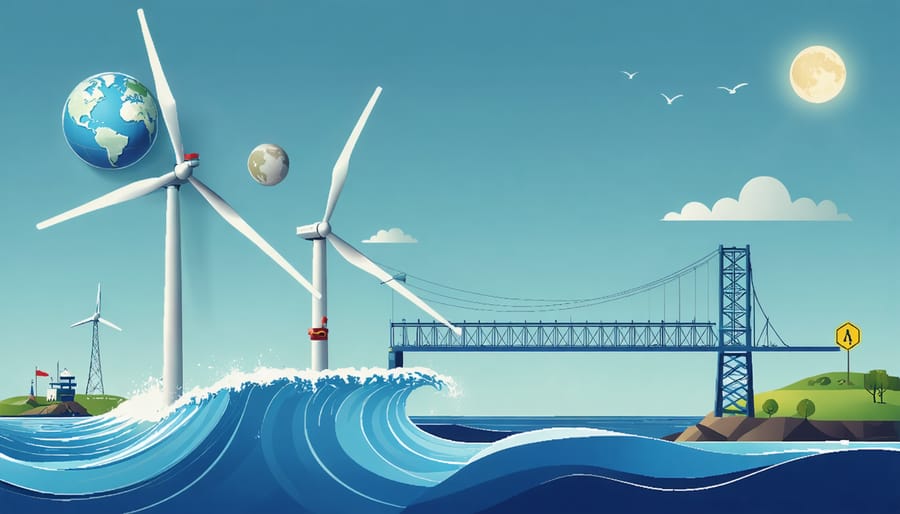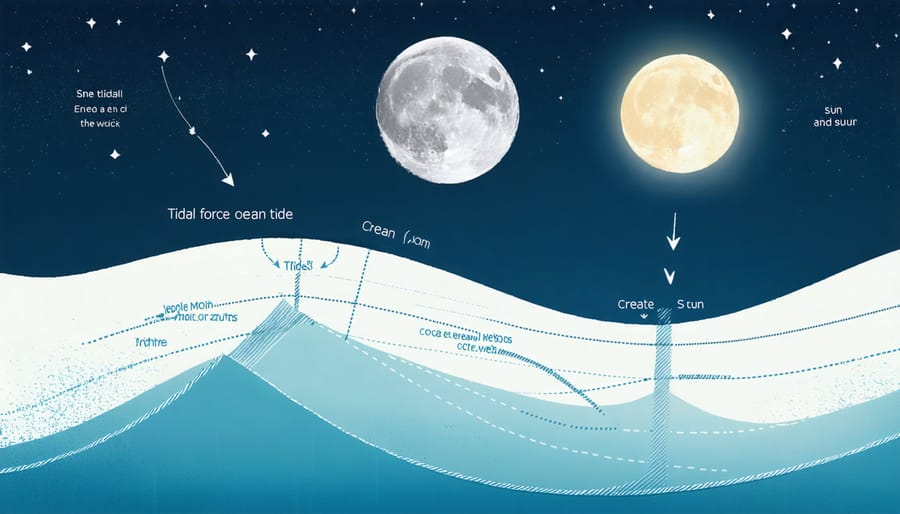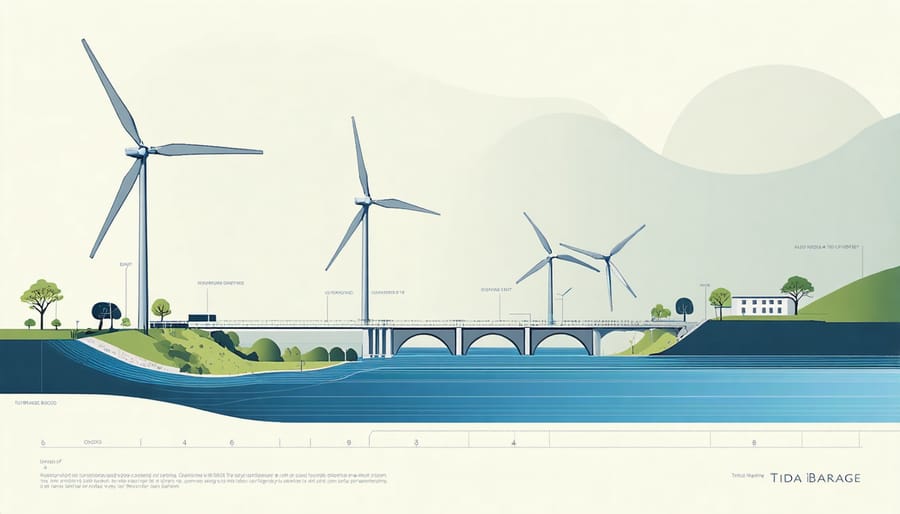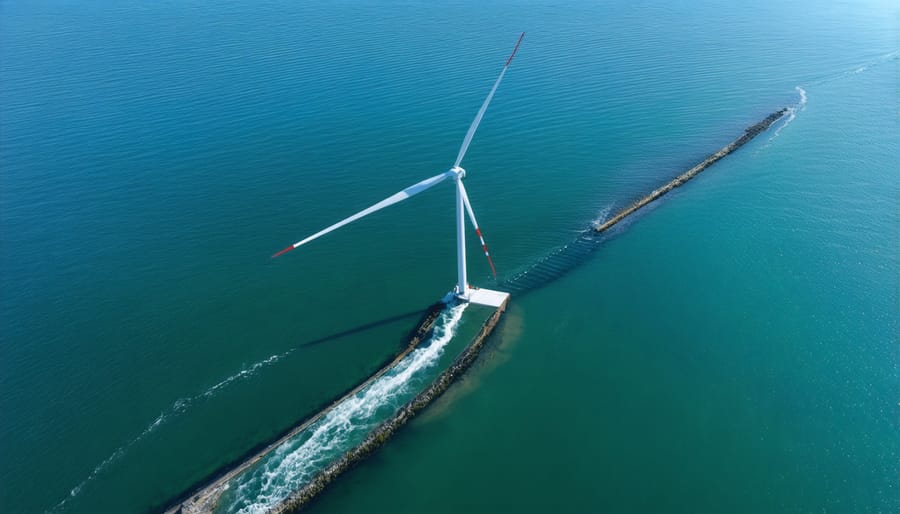Tidal Energy: The Next Wave in Europe’s Renewable Power Integration

Harnessing the ocean’s powerful rhythms, tidal energy emerges as one of the most promising renewable energy systems of our time. Unlike wind or solar power, tidal energy offers remarkable predictability, generating electricity through the consistent ebb and flow of ocean tides. This natural phenomenon, driven by gravitational forces between Earth, Moon, and Sun, creates massive water movements that can be converted into clean, reliable power.
European coastlines, particularly in countries like France, the UK, and Norway, hold immense potential for tidal energy exploitation. The technology works through two primary methods: tidal stream generators, which function like underwater wind turbines, and tidal barrage systems, which operate similarly to hydroelectric dams. These innovations capture kinetic energy from flowing water and transform it into electricity, providing a sustainable power source for coastal communities.
Modern tidal energy systems can generate electricity during both incoming and outgoing tides, maximizing efficiency and power output. With advancing technology and growing investment in marine energy infrastructure, tidal power stands poised to become a cornerstone of Europe’s renewable energy future.
The Science Behind Tidal Energy Generation
Understanding Tidal Forces
Tidal forces, the fundamental drivers of tidal energy, result from the gravitational interactions between the Earth, Moon, and Sun. These celestial bodies create a complex dance of gravitational pull that affects our oceans, causing them to rise and fall in predictable patterns. The Moon, being closest to Earth, exerts the strongest influence, creating two daily high tides and two low tides in most coastal areas.
When the Moon orbits around the Earth, its gravitational force pulls on both the ocean and the solid Earth. The ocean, being fluid, responds more dramatically to this pull than solid land, creating a bulge on both the side facing the Moon and the opposite side. As the Earth rotates, different regions pass through these bulges, experiencing high and low tides.
The Sun also plays a significant role in tidal patterns, though its effect is less pronounced due to its greater distance. When the Sun and Moon align during new and full moons, their combined gravitational forces create more extreme variations known as spring tides. Conversely, when they form a right angle with Earth during quarter moons, we experience neap tides with smaller variations.
Understanding these predictable patterns is crucial for harnessing tidal energy effectively. The regular timing and reliability of tidal forces make them an attractive renewable energy source, particularly in regions with significant tidal ranges.

Types of Tidal Energy Systems
Modern tidal energy systems harness the power of ocean tides through three primary collection methods, each suited to different marine environments and energy requirements.
Tidal barrages, similar to traditional hydroelectric dams, operate by creating a physical barrier across tidal inlets or estuaries. During high tide, water flows through turbines into a basin, and during low tide, the stored water is released back through the turbines, generating electricity in both directions. The La Rance Tidal Power Station in France exemplifies this technology’s successful implementation in European waters.
Tidal stream generators function like underwater wind turbines, utilizing arrays of turbines placed directly in tidal currents. These systems are particularly effective in channels between islands or in coastal areas with strong tidal flows. The MeyGen project in Scotland demonstrates how these systems can provide reliable renewable energy while minimising environmental impact.
The newest innovation in tidal energy is the dynamic tidal power system, which consists of long dams extending perpendicular to the coastline. This design creates significant water level differences on opposite sides of the dam, driving turbines without requiring a barrier across an entire inlet.
Each system offers unique advantages, from the proven reliability of barrages to the minimal visual impact of stream generators, making tidal energy an increasingly viable option for coastal communities seeking sustainable power solutions.

Integrating Tidal and Solar Power Systems
Complementary Power Generation Cycles
One of the most compelling advantages of tidal energy lies in its predictable generation patterns, which effectively complement solar power production. While solar panels generate electricity during daylight hours, tidal turbines harness energy from the ocean’s rhythmic movements throughout the day and night. This natural synchronization creates opportunities for more reliable and consistent power generation through hybrid energy systems.
The complementary nature of these technologies becomes particularly valuable during winter months in European regions, when solar production typically decreases. Tidal energy maintains its steady output regardless of seasonal changes, helping to balance the grid’s power supply. During summer, when solar generation peaks, the combined output of both systems can meet higher energy demands, especially during peak consumption hours.
This synergy extends beyond daily cycles. Tidal patterns, influenced by lunar phases, operate on predictable 12.4-hour cycles, creating four distinct power generation peaks daily. When integrated with solar power, which peaks during midday, the combined system provides a more consistent energy supply throughout the 24-hour cycle. This predictability allows grid operators to optimize power distribution and reduce reliance on conventional backup power sources, contributing to a more stable and sustainable energy network.
Grid Integration Solutions
Integrating tidal energy into existing power networks requires sophisticated management systems and innovative storage solutions. Modern smart grid integration technologies enable seamless coordination between tidal and other renewable sources, particularly solar power.
Advanced control systems monitor tidal patterns and solar generation in real-time, automatically adjusting power distribution to maintain grid stability. When tidal energy production peaks during strong currents, excess power can be stored in grid-scale batteries or pumped hydro facilities, ready for use during periods of lower generation.
The predictable nature of tidal energy complements solar power’s daily cycle. While solar panels generate electricity during daylight hours, tidal turbines can provide consistent power based on known tidal schedules. This complementary relationship helps create a more reliable renewable energy network.
European grid operators utilize sophisticated forecasting tools to anticipate power generation from both sources. These systems optimize power distribution, ensuring efficient delivery to consumers while maintaining grid frequency and voltage stability. Load-balancing mechanisms automatically redistribute power across regions, maximizing the utilization of available renewable energy resources.
The integration process also involves protective measures against potential grid disruptions, including automated shutdown systems and redundant power routing capabilities, ensuring continuous power supply to critical infrastructure.
Energy Storage and Management
The intermittent nature of tidal energy necessitates robust energy storage solutions to ensure consistent power supply. Modern tidal energy facilities employ various storage technologies, with pumped hydro storage and advanced battery systems being the most prevalent options. These systems store excess energy during peak tidal flows and release it during slack periods, maintaining grid stability.
Smart grid management plays a crucial role in optimizing tidal energy integration. Advanced monitoring systems track tidal patterns, energy demand, and storage levels in real-time, automatically adjusting power distribution for maximum efficiency. This intelligent management ensures optimal utilization of available resources while maintaining grid stability.
Hybrid storage systems, combining different storage technologies, are gaining popularity in European tidal energy projects. These systems typically integrate short-term battery storage for rapid response with longer-term solutions like hydrogen fuel cells or compressed air storage. This multi-layered approach provides both immediate power regulation and extended storage capabilities.
Grid operators are implementing sophisticated demand-response mechanisms to balance tidal power generation with consumption patterns. These systems use predictive analytics to forecast tidal energy availability and adjust storage strategies accordingly. The integration of artificial intelligence and machine learning further enhances system efficiency, enabling more precise energy management and reduced wastage.
European Tidal Energy Projects
Success Stories and Case Studies
Several notable tidal energy projects across Europe demonstrate the growing success of this renewable technology. In Scotland, the MeyGen project in the Pentland Firth stands as Europe’s largest operational tidal stream array. Since its launch in 2016, the project has generated over 37 GWh of clean electricity, powering approximately 12,000 Scottish homes.
France’s Rance Tidal Power Station, operational since 1966, remains a pioneering example of sustained tidal energy production. This facility generates 240 GWh annually, supplying electricity to 225,000 homes in Brittany. Its long-term success has provided valuable insights into tidal barrage technology and maintenance requirements.
The Netherlands has successfully implemented smaller-scale tidal projects, including the Eastern Scheldt Tidal Power plant. This innovative installation combines flood protection infrastructure with renewable energy generation, producing enough electricity for 1,000 households while maintaining crucial coastal defence systems.
In Nova Scotia, Canada, the FORCE (Fundy Ocean Research Center for Energy) project demonstrates international collaboration, with European technology providers playing key roles. The project harnesses the Bay of Fundy’s powerful tides, achieving record-breaking power generation efficiency rates of up to 80%.
These successful implementations showcase tidal energy’s reliability and potential for integration into national power grids, while contributing significantly to carbon reduction goals and energy independence.

Future Development Plans
The European Union has set ambitious targets for tidal energy development, aiming to install 1 GW of ocean energy capacity by 2030. Several groundbreaking projects are already underway, showcasing Europe’s commitment to harnessing tidal power. The MeyGen project in Scotland’s Pentland Firth, currently Europe’s largest operational tidal stream project, is planning a significant expansion that will power over 175,000 homes.
France is advancing its tidal energy aspirations with the Raz Blanchard pilot project, which will feature innovative bi-directional turbines designed to generate power during both incoming and outgoing tides. The Netherlands is developing the Eastern Scheldt Tidal Power plant, incorporating new adaptive turbine technology that optimizes energy capture while minimizing environmental impact.
Industry experts anticipate breakthrough developments in turbine efficiency and durability, with next-generation materials and smart monitoring systems playing crucial roles. Research focuses on reducing installation costs and improving grid integration capabilities, making tidal energy more commercially viable.
The European Marine Energy Centre (EMEC) continues to serve as a vital testing ground for new tidal technologies, with several promising innovations in various stages of development. These include floating tidal platforms and modular tidal arrays that can be scaled according to energy demands. Cross-border collaboration between European nations is strengthening, with shared funding initiatives and knowledge exchange programs accelerating the sector’s growth.
Environmental and Economic Impact
Environmental Considerations
Tidal energy stands out as one of the most environmentally conscious forms of renewable power generation, though its implementation requires careful consideration of marine ecosystems. The installation of tidal turbines and barrages can temporarily disrupt local marine habitats during construction phases, requiring thorough environmental impact assessments before project approval.
However, once operational, tidal energy systems have minimal ongoing environmental impact. Unlike fossil fuels, they produce no greenhouse gas emissions or pollutants. Modern tidal installations incorporate fish-friendly turbine designs and migration passages to protect marine life. Studies from European tidal projects show that marine ecosystems often adapt well to these installations, with some even creating artificial reef environments that enhance biodiversity.
The predictable nature of tidal energy also means fewer backup power systems are needed, reducing the overall environmental footprint of electricity generation. Additionally, tidal installations have proven remarkably durable, with expected lifespans of 20-30 years, minimizing the need for frequent replacement and associated environmental disruption. This longevity, combined with zero fuel requirements, makes tidal energy a sustainable solution for coastal communities.
Economic Viability
The economic viability of tidal energy projects continues to improve as technology advances and installation costs decrease. Initial capital investments remain significant, ranging from €2,000 to €4,000 per kilowatt of installed capacity for commercial-scale installations. However, these costs are offset by minimal operational expenses and an exceptionally long facility lifespan of 40-100 years.
Tidal energy’s predictability offers a distinct advantage over other renewable sources, enabling accurate long-term revenue forecasting and stable power generation planning. Operating costs typically fall between €0.021 and €0.035 per kilowatt-hour, comparing favourably with conventional power sources when considering the entire lifecycle.
European coastal regions benefit particularly from tidal energy investments through job creation in manufacturing, installation, and maintenance sectors. Studies indicate that a single tidal energy facility can generate up to 100 direct jobs and support an additional 300 indirect positions in related industries.
While current costs exceed some other renewable options, industry projections suggest a 30-40% cost reduction by 2030 as deployment scales up and technology matures. This trajectory, combined with increasing carbon pricing and renewable energy incentives, strengthens the long-term economic case for tidal energy investment.
The integration of tidal and solar energy systems represents a groundbreaking approach to renewable power generation, particularly for European coastal regions. By combining the predictable nature of tidal energy with the widespread availability of solar power, we can create more reliable and efficient renewable energy networks. This hybrid approach not only maximizes energy production potential but also addresses the intermittency challenges often associated with individual renewable sources. The successful implementation of such integrated systems across Europe demonstrates their viability for both industrial and residential applications, while ongoing technological advancements continue to improve efficiency and reduce costs. As we move towards a sustainable energy future, the synergy between tidal and solar power stands as a testament to innovation in renewable energy, offering a promising solution for meeting Europe’s growing energy demands while supporting climate goals.
Leave a Reply